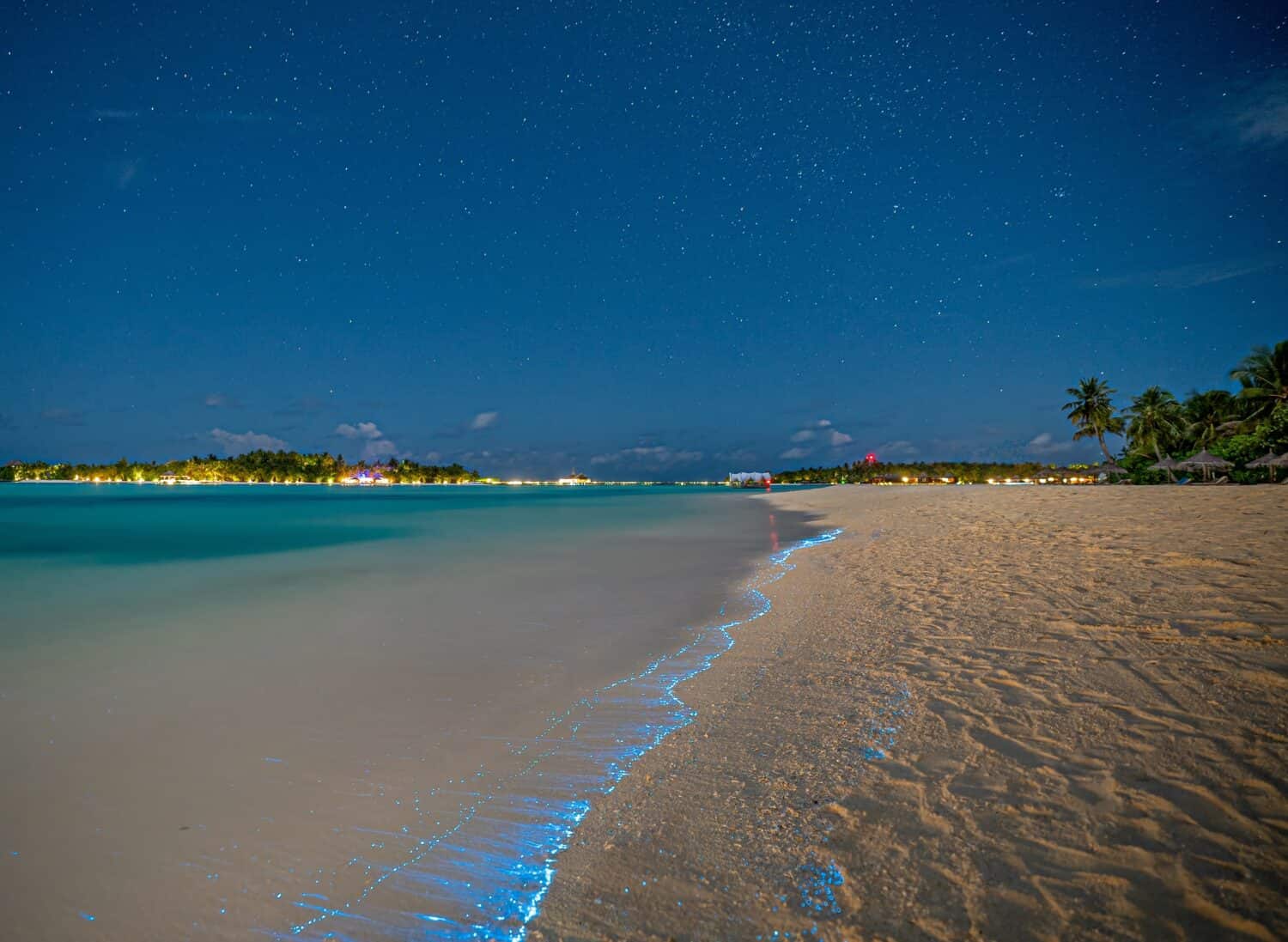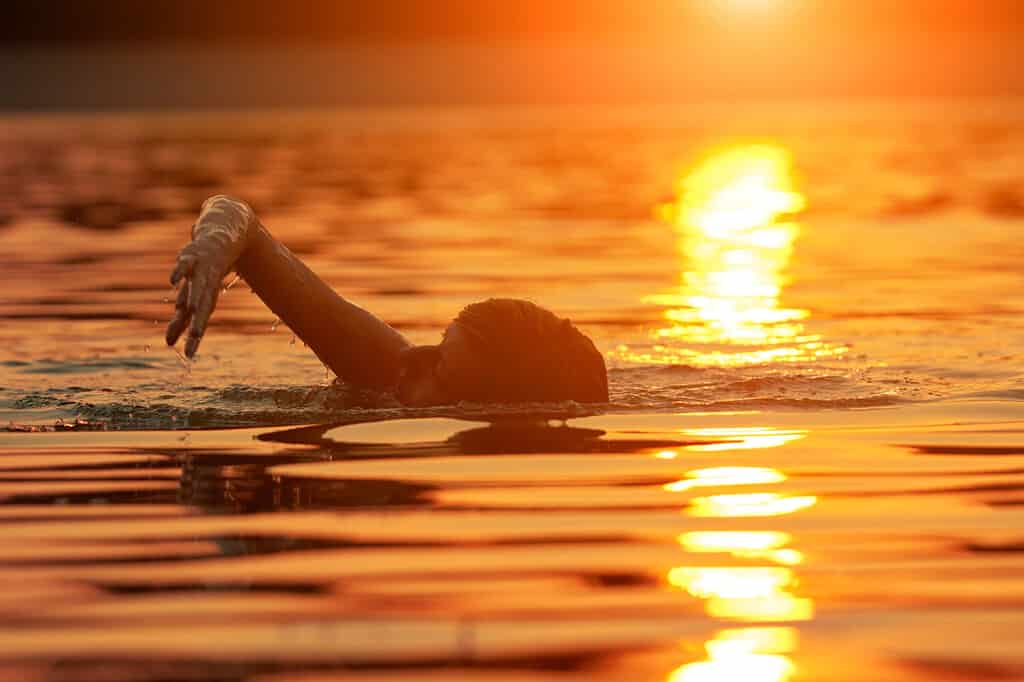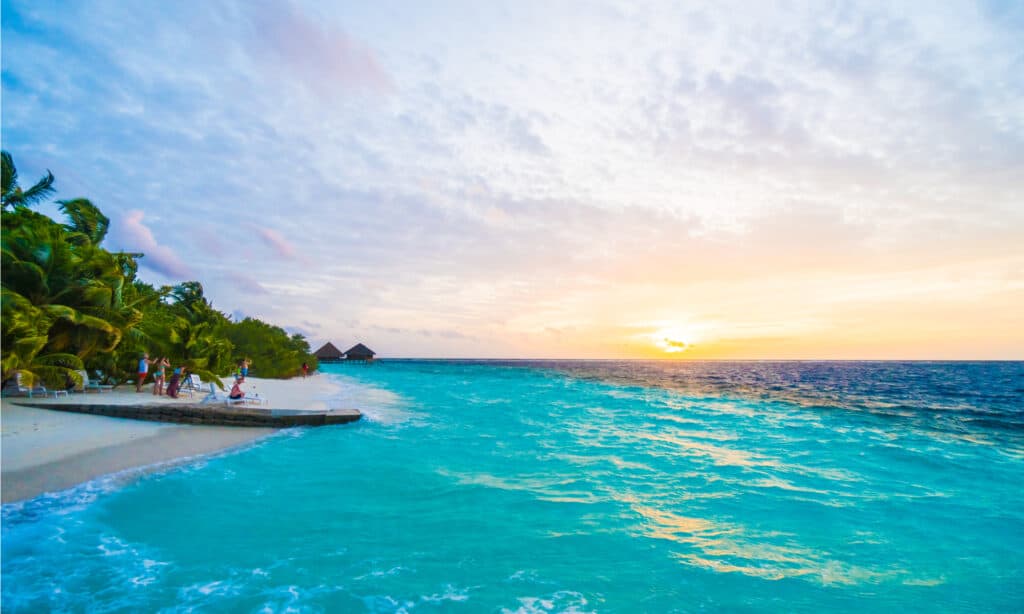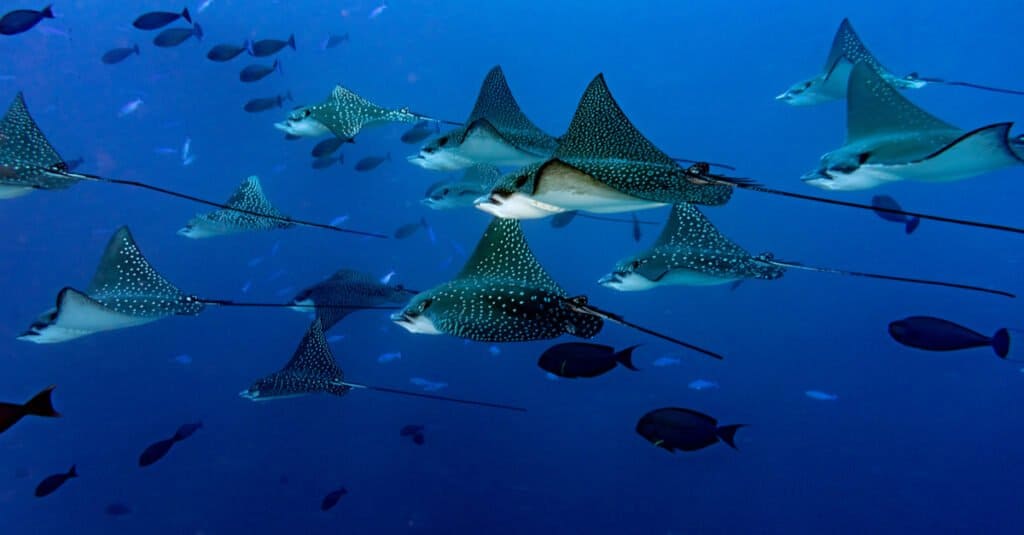Tucked in the Indian Ocean, the Maldives are a series of islands and atolls that make up the most dispersed country in the world. Its borders include over 35,000 square miles of space, but less than 300 square miles of that is dry land! The Maldives have a lot to offer water lovers, as well as anyone in search of amazing reefs and a tropical getaway. The islands are situated right along the equator, and the reefs that make up its many atolls offer amazing snorkeling opportunities.
One of the most amazing features of the Maldives, however, is its Sea of Stars phenomenon. During the wet season — which extends from May to November — the waves along the many beaches glow with hundreds of little blue lights that highlight the ebb and flow of the current. This unforgettable sight draws people from around the world to the Maldives, but what causes the Sea of Stars? Is it safe? Let’s dive in and find out!
What Makes It Glow?

The natural bioluminescence is best seen at night.
©nabyh/Shutterstock.com
Water doesn’t usually glow. In the Sea of Stars, it’s not the water that’s glowing. It’s plankton! The tiny creatures thrive in the water around the area’s reefs and decorate the waves at night. Technically they glow all day, but our eyes can’t see them when the sun’s out.
These plankton, which are a particular kind of phytoplankton called Lingulodinium polyedrum, give off a natural bioluminescence similar to that of a firefly. The waves and other disturbances trigger their glow, especially when oxygen mixes with the water. Through a chemical reaction, the plankton produce their glow and stand out like stars in the dark waves.
Glowing Prey
The bioluminescence of Lingulodinium polyedrum evolved as a defense mechanism against predators. Though the plankton can move around, they aren’t very fast and make for an easy meal. Many of the different fish species that live in reefs eat plankton, and because plankton are so small, they have to eat a lot of plankton.
So Lingulodinium polyedrum evolved. Their bioluminescence continues to glow even after they’ve been eaten, which can cause their predator to glow as well. If a fish eats enough of the Lingulodinium polyedrum, it will begin to glow too — which then makes it more visible to its own predators. Seems like a round-about way to dissuade your enemies, but no one ever said evolution was straightforward!
Did you know most bioluminescent organisms live in the ocean? Some types of fish, bacteria, and jellyfish glow through similar chemical reactions. Almost no bioluminescent creatures live in freshwater, and only a few live on land, like fireflies, some types of fungi, and glow worms.
Is It Safe to Swim In?

Swimming amongst the Sea of Stars is a magical experience.
©True Touch Lifestyle/Shutterstock.com
Yes! The tiny plankton and their beautiful glow pose no threat to humans, so it’s perfectly safe to swim in the Sea of Stars. In fact, because swimming — or just walking along the beach in the surf — can introduce more oxygen to the air, the glow will get even stronger around you!
Swimming is a popular activity during the Sea of Stars phenomenon, as is snorkeling. Many businesses in the area rent the equipment you’ll need for any water-based activity, and some also offer night tours and group events so you can make the most of this magical experience.
Not a fan of being in the water? There are still many great ways to enjoy the glow! Many restaurants feature outdoor dining, so you can take in the sights along with a great meal. Also, a simple walk on the beach will bring you as close to the action as you care to be. Lastly, you’d be hard-pressed to find accommodations without a balcony or patio, which is perfect for sitting back and enjoying the view.
Where and When?
Though it’s possible to see the Sea of Stars any time in the wet season, it’s also possible to visit the Maldives and not see it. Many different variables impact the phenomenon, making it more difficult to predict. Everything from air temperature and water temperature to the saltiness of the water, tidal shifts, and nutrient density contribute to the Sea of Stars. Enjoying this phenomenon can be a “right place, right time” adventure.
Locals say the phenomenon is most likely to occur in the late summer when the temperatures hover between 80 and 90 degrees F during the day but drop considerably at night. The Sea of Stars occurs throughout the thousands of islands in the Maldives, but Vaadhoo Island is one of the best — and most popular — viewing spots. The island sits next to a lagoon that’s completely surrounded by a reef, which is the perfect place for Lingulodinium polyedrum to thrive. Visitors to Mudhdhoo Island, farther south also have a higher chance of seeing the phenomenon.
The Maldives

Crystal-clear waters surround the many islands of the Maldives.
©Lifestyle Travel Photo/Shutterstock.com
A nation of islands, the Maldives includes 1,192 islands grouped into a double chain of 26 atolls. Atolls are ring-shaped reefs, islands, or strings of islets that protect a lagoon at the center. Thought to form with the death and erosion of volcanoes, atolls feature unique coral structures, geographies, and flora and fauna. The Maldives is home to approximately five percent of the world’s coral reefs. These ribbons of color tie the islands together with both hard and soft corals and provide homes to thousands of species of fish. Even larger aquatic creatures like manta rays and whale sharks make their homes in these waters.
The Maldives is made up of nearly 1,200 islands, but only about 200 of those are inhabited. Some are used for industry and agriculture, while some house expansive resorts. The white sand beaches, clear blue waters, and a vast array of activities make the Maldives an irresistible tropical destination for many. In fact, tourism makes up a large part of the Maldivian economy, followed closely by fishery. “Budget” accommodations don’t exist here — the islands brim with luxury resorts, suites over the water, and even underwater restaurants!
One-third of the Maldivian population lives in its capital city, Malé, while the rest of its people live distributed throughout the islands. Maldivian people have a diverse variety of physical features, thanks to its history as a melting pot for the many seafaring cultures in the area. Home to a rich culture of history, craft, music, and dance, the Maldives are unlike anywhere else.
Animals in the Maldives

A group of eagle stingrays off the Maldives in the Indian Ocean.
©Andrea Izzotti/Shutterstock.com
Like many island nations, the fauna of the Maldives is incredibly unique and diverse. Many of the creatures that call the Maldives home live in the water — some 2,000 aquatic species live around the islands, including turtles, reef fish, and eels. Many other native animals include lizards, a dazzling variety of birds, toads, and more. Here’s a list of some of the incredible animals in the Maldives.
- Fruit bats or flying foxes
- Agamid lizards, Oriental garden lizards, and skinks
- Wolf, Blind, and Pelagic sea snakes
- Green, Leatherback, and Hawksbill turtles
- Fairy Terns, Herons, Sandpipers, and White-tailed tropicbirds
- Spotted, Spinner, and Rough-toothed Dolphins
- Dwarf sperm, Longman’s beaked, Blue, and Bryde’s whales
- Whale, Reef, Hammerhead, and Nurse sharks
- Stingrays, Manta rays, and Eagle rays
- Clownfish, Parrotfish, Barracuda, and Squirrelfish
Other Seas of Stars
Lingulodinium polyedrum don’t just live in the Maldives. The glowing plankton also appear in other parts of the world. Here’s a list of a few other places to see this incredible phenomenon!
- Puerto Rico is home to three glowing bays: Mosquito Bay, Laguna Grande, and La Parguera
- Koh Rong, Cambodia
- Koh Phi Phi and Ton Sai Beach, Thailand
- Golfo Dulce, Costa Rica
- Manialtepec Lagoon, Mexico
- Indian River Lagoon in Florida includes both glowing plankton and jellyfish
- Mission Bay in California can glow during “red tides” of algae and plankton
These glowing plankton thrive in warm ocean conditions and create similarly breathtaking views wherever they appear. However, these phenomena are even harder to predict outside of the Maldives. Unless you truly get lucky, your best bet to experience the Sea of Stars is to visit the equally beautiful Maldives.
Other places, like Toyama Bay in Japan, offer a similarly spectacular glow show with very different “stars.” Firefly squid and jellyfish can create beautiful fluorescent scenes, though it’s not as safe to swim among them.
Summary
The Sea of Stars phenomenon offers everyone a chance to safely swim amongst the “stars.” In reality, you’ll be taking a swim with thousands of bioluminescent plankton reacting to oxygen in the water! Regardless of the mundane facts, the bright blue lights floating along the surf make for an unforgettable experience that’s well worth a trip to the Maldives. The white sand beaches and clear, turquoise waters of the island nation spell rest and relaxation. It’s no wonder why people from around the world visit the Maldives, and with the right planning and a little luck, you can experience the Sea of Stars while you’re there.
The photo featured at the top of this post is © Johanna Brehmer / CC BY-SA 4.0 – License / Original
Thank you for reading! Have some feedback for us? Contact the AZ Animals editorial team.







